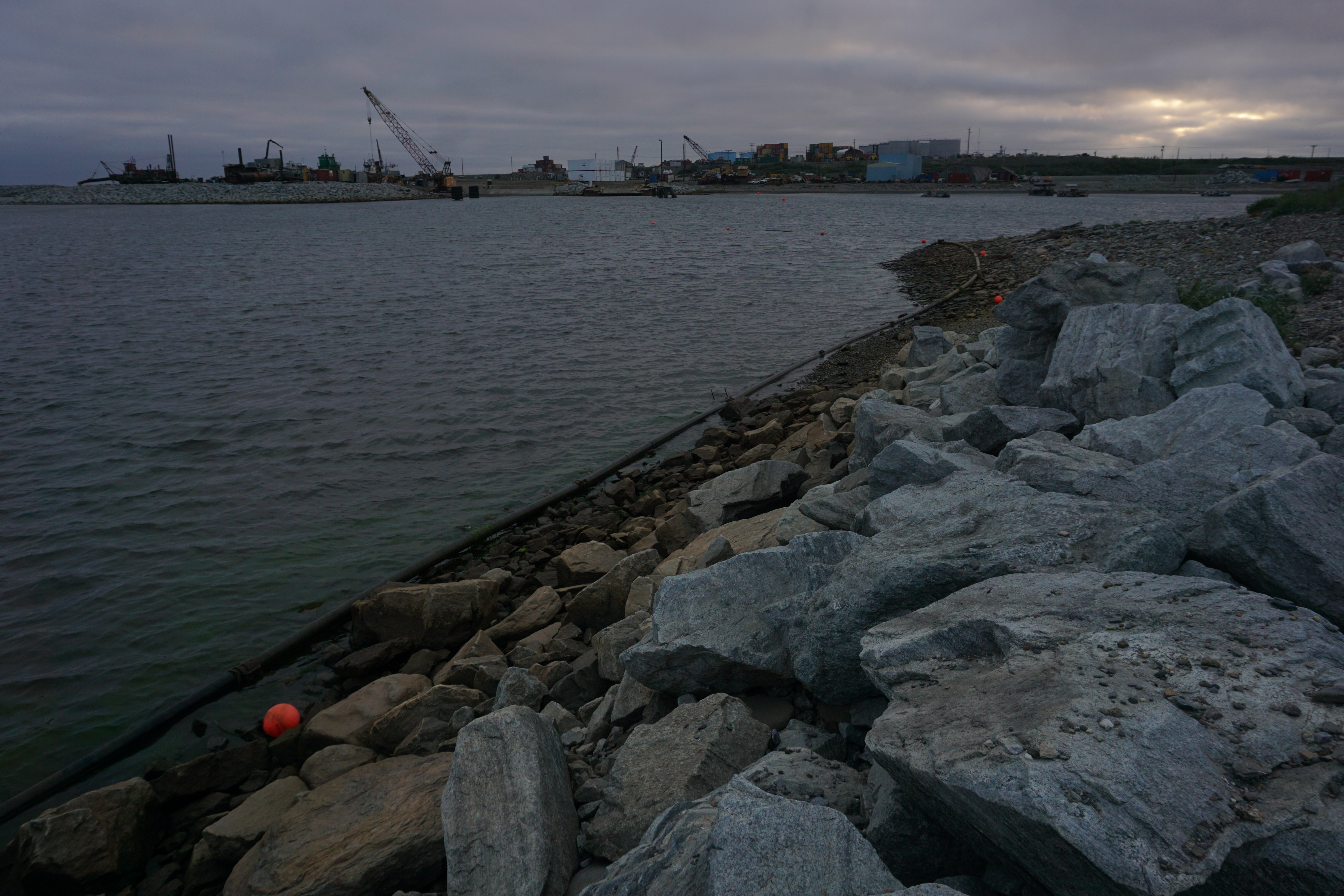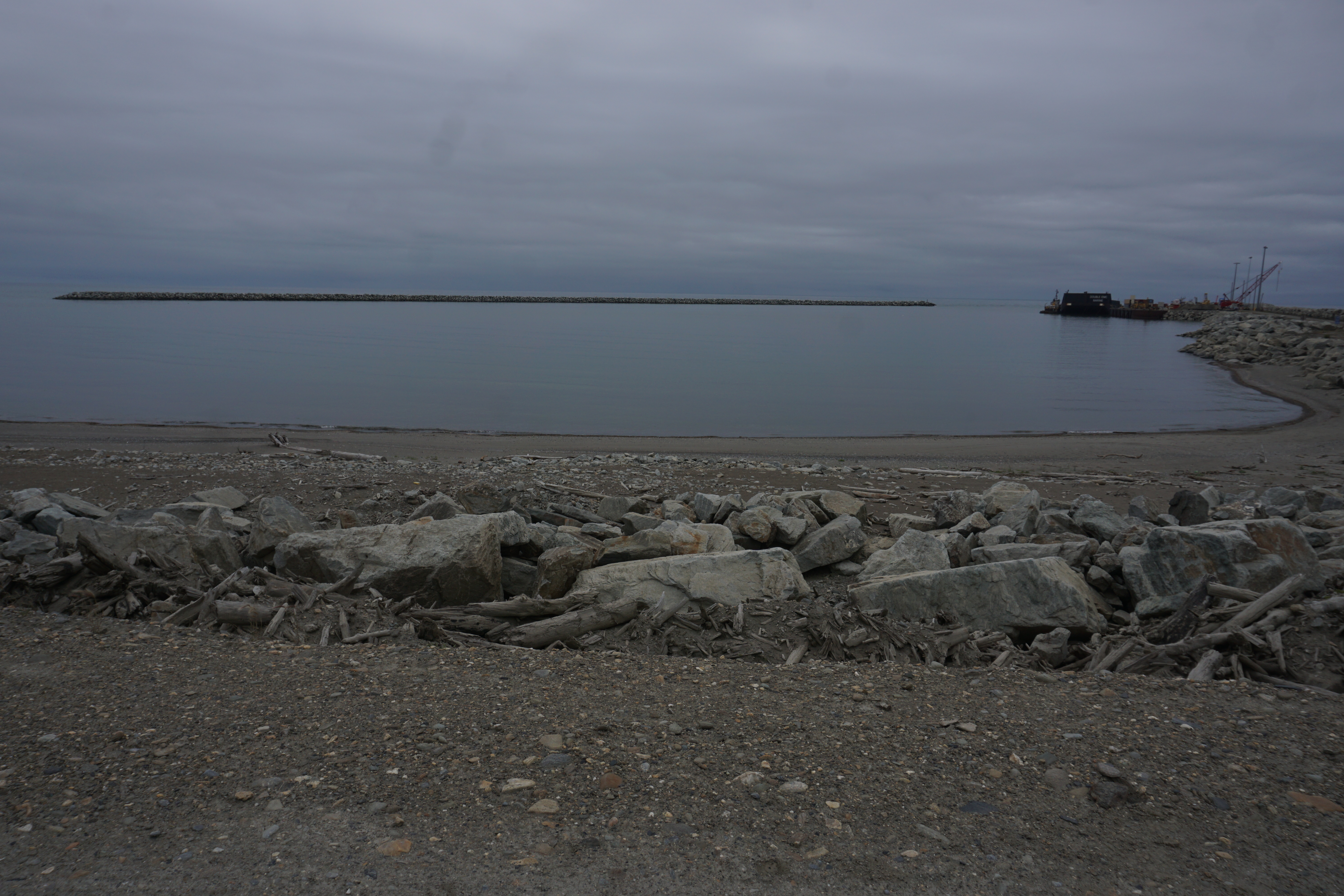New Nome port expansion plans add marine animal protections, but don’t increase depth
The new draft is open for public comment through January 30, and a final report is due this spring.

The latest draft of a feasibility study for expanding the port of Nome, a key port in the U.S. Arctic, narrows expansion options and includes some configuration changes, but doesn’t call for deeper dredging — a key consideration for any future uses.
The draft was released at the end of December by the U.S. Army Corps of Engineers. Its release triggers a period ending January 30 during which the public can submit additional comments.
The Corps of Engineers recommend the “Alternative 8b” plan, which would deepen the port to 40 feet and dredge an outer basin to 28 feet, in addition to other projects in the port.
The total cost is estimated at $491 million.
The Corps of Engineers released an earlier version of the report last May, and this draft incorporates some of the public comments received at that time.
One significant change addresses the effects of construction on endangered and protected marine animals. To minimize the effects, including noise from pile-driving work, the engineers propose changing the dock design from a concrete caisson to a sheet pile dock.
In addition, the east causeway proposed in Alternatives 8a and 8b has been replaced with a combination of causeway and breakwater.

This draft report narrowed the alternatives down from 13 to seven, as well as the option of taking no action. Other changes to the various options include making changes to the existing breakwater, converting all or part of it to a causeway and creating different numbers of docks.
The alternative favored by the Corps of Engineers would still dredge the port to 40 feet. In May, Rep. Sean Maloney, a Democrat from New York, raised concerns about that depth. He said the port needed to be at least 45 feet deep in order to accommodate larger ships from the Coast Guard and Navy.
At the time, Joy Baker, Nome’s port director, told ArcticToday that such details would be sorted out in the public comment periods, the first of which ended in June.
“If it needs to be 41 or 42 [feet], that’ll be sorted out when we go into final refinement before the report goes final and up to headquarters, which is towards the end of the year, first part of next year,” she said in May. “So, there’s plenty of time to weed out the specifics.”
Baker later told ArcticToday that the analysis revealed a 40-foot depth would be adequate for icebreakers and Arleigh Burke-class destroyers. The Port of Nome and the Corps of Engineers have communicated with both the U.S. Coast Guard and Navy, she said, and the 40-foot depth recommended in the report will meet their needs. (ArcticToday reached out to both services, and will update this story if they respond.)
Alternative 8a, which the Corps ruled cost-ineffective, would dredge up to 45 feet deep.
The cost of the study was split with the City of Nome, and the federal funding came from the Water Resources Development Act, a civil works bill. The purpose of this report was to examine the ways in which a port in Nome would address the community’s growing infrastructure needs, especially in a rapidly changing climate.
The study aimed to identify “a feasible solution that provides safe, reliable, and efficient navigation and mooring for vessels” serving Nome, the report says. Improving navigation could reduce the costs of goods being shipped into Nome — including construction materials to make aging infrastructure more resilient in the face of thawing permafrost, coastal erosion, rising sea levels and stronger storms.
One section of WRDA 2016, however, does concede that such a port could provide “national security benefits,” and instructs the Corps of Engineers to consult with the Coast Guard and Defense Department on security uses.
In Washington, lawmakers have frequently focused on an Arctic port’s national defense potential.
The 2020 National Defense Authorization Act (NDAA) calls for the potential designation — but not the construction — of an Arctic strategic port.
And recent legislation introduced to the Senate would create a strategic port or ports to accommodate large military vessels in the Arctic. Sen. Dan Sullivan, a Republican from Alaska who introduced the bill, told ArcticToday that Nome was one of the options for such a strategic port.
Lawson Brigham, a researcher at the University of Alaska Fairbanks and a fellow at the Wilson Center’s Polar Institute, told ArcticToday in an email that “Nome is the only viable place for an initial ‘Arctic port.’”
Nome’s location near the Bering Strait is critical in linking the Pacific and Arctic oceans, he pointed out, and facilitating international maritime traffic.
The Corps of Engineers should receive funding to construct an outer breakwater and wharf, Brigham said, and dredge the existing port to a depth of 40 to 45 feet.
Brigham said these “modest” infrastructure investments would allow access for a Coast Guard icebreaker, naval combatants, NOAA research ships, commercial vessels and more.
Public comments on the new draft report are open until January 30. The final report is expected to be released this spring and delivered to Congress in summer 2020.
This story has been updated.